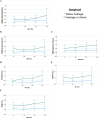Behavioral and psychological symptoms of dementia and Alzheimer's disease progression in Down syndrome
- PMID: 40217501
- PMCID: PMC11987311
- DOI: 10.1186/s11689-025-09604-w
Behavioral and psychological symptoms of dementia and Alzheimer's disease progression in Down syndrome
Abstract
Background: Adults with Down syndrome (DS) have a 90% lifetime risk for Alzheimer's disease (AD), with neurobiological pathology present decades prior to dementia onset. The profile and timing of cognitive decline in DS is well-documented. However, there is a small body of research on whether Behavioral and Psychological Symptoms of Dementia (BPSD) occur early on in the progression of AD in DS and are associated with early AD pathology (i.e., amyloid-beta [Aβ] and neurofibrillary tau tangles [NFT]).
Methods: Data were analyzed from 337 adults with DS (M = 45.13 years, SD = 9.53 years) enrolled in a large cohort study. The Reiss Screen for Maladaptive Behavior (RSMB) measured common behaviors reported in BPSD across up to four study cycles (spaced approximately 16 months apart). Linear mixed models estimated change in BPSD as predicted by baseline (a) dementia status (i.e., cognitively stable, mild cognitive impairment [MCI], or dementia), (b) Aβ positron emission tomography (PET) tracer [11C] PiB, and (c) NFT PET tracer [18F]AV-1451. Models controlled for chronological age, sex, study site, premorbid intellectual disability level, APOE e4 allele carrier status, psychiatric diagnoses, and psychiatric medication use.
Results: Compared to cognitively stable participants, participants whose status was MCI or dementia, had significantly higher baseline RSMB subdomain scores. Increases in RSMB Depression-Behavioral, Depression-Physical, and Psychosis were observed for participants with MCI. Higher baseline Aβ and NFT were associated with higher RSMB Avoidant at baseline, and increases in RSMB Depression-Physical and Psychosis over time.
Conclusions: BPSD are an important part of AD in DS, particularly during the prodromal stage. Elevated Aβ and NFT predict higher initial avoidance and change in physical depression behaviors and may indicate MCI in adults with DS. Broader increases in BPSD are observed as adults with DS progress from early to late-stage dementia. Clinicians should rule out other possible causes of BPSD when screening for AD, such as stressful life experiences or co-occurring medical conditions. Caregivers of adults with DS should have resources on BPSD management and self-care strategies.
Keywords: Alzheimer’s disease; Amyloid; Down syndrome; Psychiatric symptoms; Tau.
© 2025. The Author(s).
Conflict of interest statement
Declarations. Ethics approval and consent to participate: This multi-site study was approved by the Internal Review Boards of the University of Pittsburgh, University of Wisconsin Madison, and University of California, Irvine. Consent for publication: Not applicable. Competing interests: The authors declare no competing interests.
Figures



References
-
- Annus T, Wilson LR, Hong YT, Acosta-Cabronero J, Fryer TD, Cardenas-Blanco A, Smith R, Boros I, Coles JP, Aigbirhio FI, Menon DK, Zaman SH, Nestor PJ, Holland AJ. The pattern of amyloid accumulation in the brains of adults with Down syndrome. Alzheimers Dement. 2016;12(5):538–45. 10.1016/j.jalz.2015.07.490. - PMC - PubMed
-
- Lao PJ, Betthauser TJ, Hillmer AT, Price JC, Klunk WE, Mihaila I, Higgins AT, Bulova PD, Hartley SL, Hardison R, Tumuluru RV, Murali D, Mathis CA, Cohen AD, Barnhart TE, Devenny DA, Mailick MR, Johnson SC, Handen BL, Christian BT. The effects of normal aging on amyloid-β deposition in nondemented adults with Down syndrome as imaged by carbon 11-labeled Pittsburgh compound B. Alzheimers Dement. 2016;12(4):380–90. 10.1016/j.jalz.2015.05.013. - PMC - PubMed
-
- Lemere CA, Blusztajn JK, Yamaguchi H, Wisniewski T, Saido TC, Selkoe D. Sequence of deposition of heterogeneous amyloid β-peptides and APOE in Down syndrome: Implications for initial events in amyloid plaque formation. Neurobiol Dis. 1996;3(1):16–32. 10.1006/nbdi.1996.0003. - PubMed
MeSH terms
Substances
Grants and funding
- P50 AG005681/AG/NIA NIH HHS/United States
- P50 HD105353/HD/NICHD NIH HHS/United States
- U01 AG051412/AG/NIA NIH HHS/United States
- P50 AG005133/AG/NIA NIH HHS/United States
- UL1 TR001414/TR/NCATS NIH HHS/United States
- UL1 TR002373/TR/NCATS NIH HHS/United States
- P30 AG062715/AG/NIA NIH HHS/United States
- U54 HD090256/HD/NICHD NIH HHS/United States
- UL1 TR002345/TR/NCATS NIH HHS/United States
- UL1 TR001857/TR/NCATS NIH HHS/United States
- U24 AG21886/National Centralized Repository for Alzheimer Disease and Related Dementias
- P30 AG062421/AG/NIA NIH HHS/United States
- P50 AG008702/AG/NIA NIH HHS/United States
- P30 AG066519/AG/NIA NIH HHS/United States
- U19 AG068054/AG/NIA NIH HHS/United States
- T32 HD007489/HD/NICHD NIH HHS/United States
- U54 HD087011/HD/NICHD NIH HHS/United States
- U01 AG051406/AG/NIA NIH HHS/United States
- UL1 TR001873/TR/NCATS NIH HHS/United States
LinkOut - more resources
Full Text Sources
Medical
Miscellaneous

